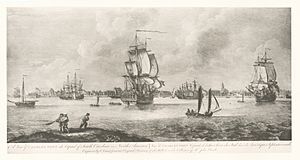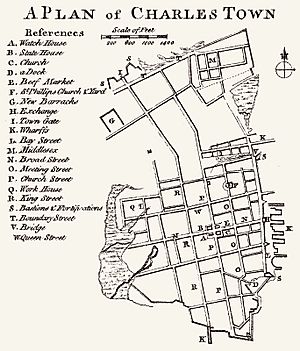Thomas Jeremiah facts for kids
Thomas Jeremiah (who died on August 18, 1775) was a free Negro man from Charles Town, South Carolina. He worked as a harbor pilot, a firefighter, a fisherman, and a merchant. Jeremiah was a well-known person in the city. He was put to death because he was accused of trying to start a revolt among enslaved people.
Contents
Biography of Thomas Jeremiah
People often called him Thomas Jerry or just Jerry back then. We don't know much about his early life, like when or where he was born. We also don't know if he was born free. At that time, most Black people in South Carolina were enslaved. Free Black people like Jeremiah usually bought their freedom from their owners.
Jeremiah first appeared in old records in the 1750s. The South-Carolina Gazette newspaper blamed him for ships getting stuck. But he got much better at his job. By 1775, people called him "one of the best pilots in the harbor." The governor even said his "Publick services were universally acknowledged." Jeremiah also owned enslaved people. He used them in his fishing business. In 1768, the South-Carolina Gazette wrote that "The Negro Jerry (well known for his extinguishing of fires) has just completed a Well-Boat." This boat helped him sell fresh fish every day in Charles Town.
People thought Jeremiah was very wealthy. His money was estimated to be around £1,000 sterling. One expert, J. William Harris, believes Jeremiah was probably the richest Black person in British North America at that time.
By the 1770s, Jeremiah was famous in Charles Town. In 1771, he was charged with assault. But people respected him so much that he received a pardon. Lieutenant Governor William Bull granted him this pardon.
The Death of Thomas Jeremiah
Why Thomas Jeremiah Died
By early 1775, people in South Carolina's capital were very excited about the revolution. Since 1765, the British Parliament had started new taxes and rules. These rules caused more and more resistance from the American colonies. The royal government in South Carolina was not working well. The Commons House of Assembly was often shut down by the royal governors.
People started forming their own groups and meetings to fight British actions. The British had blocked Boston Harbor and passed harsh laws. Because of this, a group called the General Committee called a General Meeting on July 6, 1774. This meeting chose people to go to the First Continental Congress. This was a meeting of most of Britain's colonies in North America.
The First Continental Congress met in Philadelphia from September 5 to October 26, 1774. Two delegates from South Carolina, Christopher Gadsden and Thomas Lynch, were very strong in their views against the British. In South Carolina, the General Meeting chose a group called the Committee of 99. This committee became the real government for the colony. The official royal Commons House of Assembly even supported these actions.
In late 1774, the General Meeting held elections for a new Provincial Congress. This Congress first met on January 11, 1775. Most of its members were also in the royal Commons House of Assembly. The Congress and its committees worked to take control of the province. In April, a Secret Committee took weapons from gunpowder magazines and the State House.
In May, news came of battles at Lexington and Concord. The Congress then decided to print a lot of money. They also voted to create an armed defense force. They set up a Council of Safety. Henry Laurens was its president. This new Council had almost total power in the province. South Carolina was now almost an independent state.
In May and June 1775, people in Charleston worried about two things. They feared an attack by the British. They also worried about enslaved people rising up. The Secret Committee had taken official mail in April 1775. They read about British plans to encourage Cherokee attacks and slave revolts. A group of five people from the Provincial Congress was formed. Thomas Bee led this group. Their job was to look into slave uprisings.
On June 14, 1775, this committee gave a report. It named "Jerry the pilot" among others. Jeremiah was a skilled pilot. This meant he could guide British ships into Charles Town Harbor. This skill made him a threat if there was a slave rebellion. The committee used information from two enslaved men, Jemmy and Sambo, to accuse Jeremiah.
Henry Laurens wrote a letter to his son John. He said the committee did not want to punish anyone too harshly. They only wanted "one or two Negroes...severely flogged & banished." But Henry Laurens stepped in. He pushed the committee to either free the accused if they were innocent or give them the death penalty.
A new royal governor, William Campbell, arrived in Charles Town on June 18, 1775. His predecessor had left in 1773. William Bull had been acting governor. But by then, royal power was almost gone. The official Commons House approved the Provincial Congress's money printing. Then it "simply faded out of existence."
What Happened After Thomas Jeremiah Died
Rumors spread that people wanted to harm Governor Campbell. So, Jeremiah's supporter, Governor Campbell, left the city. He went to the HMS Tamar, a warship in Charles Town harbor. He never returned to the city. All signs of royal control had disappeared.
In November, the first shots of South Carolina's revolution were fired. This happened during a three-day fight. It was between loyalist and patriot groups. The fight took place at Ninety-Six. By the end of the year, the Provincial Congress controlled all of South Carolina.
However, in early 1776, few leaders in Charles Town thought about independence. A new law still called South Carolina a colony. But in June, the British tried to invade near Charles Town. This boosted the idea of revolution. In September, the General Assembly took over from the Provincial Assembly. They adopted the Declaration of Independence. The Second Continental Congress had approved it in July. After this, there was no turning back.
Thomas Jeremiah's Legacy
After he was put to death, Thomas Jeremiah was not mentioned in public records again. We don't know what happened to his body, his wife, his enslaved people, or his other property.
For a few years after his death, people on both sides of the Revolution talked about Jeremiah. Governor Campbell sent a report about the trial to London. Lord Sandwich used it in parliament. He said it showed the "cruelty and baseness" of the colonists. The events were also mentioned in a document called "An Answer to the Declaration of the American Congress."
Henry Laurens later said, "I abhor slavery." But he never freed his own enslaved people. His son John wanted to free enslaved people. He also wanted to create a group of free Black soldiers to fight for the colonists. But the South Carolina Assembly did not approve his plan.
In early American history books, Jeremiah's story was mostly ignored. It was just a small note in John Drayton's Memoirs of the American Revolution. The last time his story was mentioned (though not very accurately) was in 1851. After that, Jeremiah was forgotten for over 100 years.
Thomas Jeremiah's life was largely unknown for 200 years after he died. J. William Harris says that a 1978 essay by Peter H. Wood brought Jeremiah's story back to public attention. Since then, many experts have written about Jeremiah. They have done this even though there are not many details about his life. They use Jeremiah's case to show important issues of his time.
His name is in the titles of books like Harris's The Hanging of Thomas Jeremiah: A Free Black Man's Encounter with Liberty. It is also in William R. Ryan's The World of Thomas Jeremiah: Charles Town on the Eve of the American Revolution. In the South Carolina Encyclopedia, Ryan suggests that "Jeremiah’s ordeal showed the three-way struggle for power." This struggle was between Black people, Whigs (Patriots), and Tories (Loyalists). It was happening in the southern colonies before the Revolutionary War.
Jeremiah has become a symbol for the situation of Black people during the revolution. His story shows how "British forces became, in effect, a force for slave liberation." However, Harris points out that both Jeremiah and his supporter William Campbell owned enslaved people themselves.



